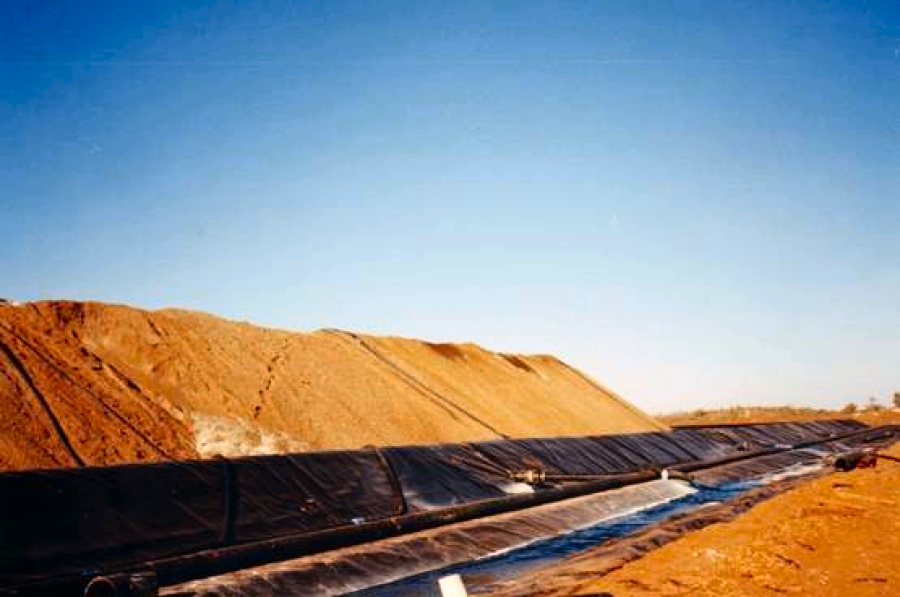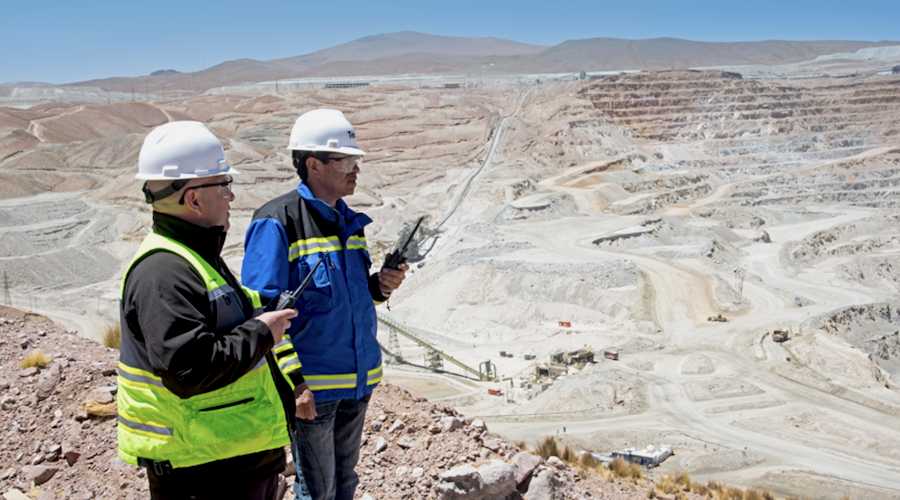Copper heap leach development – not as easy as it looks
 Heap leaching has become increasingly popular in the copper industry for treating oxide and secondary sulphide ores, and is now being extended to primary sulphide ores. The ability to use heap leaching, together with solvent extraction and electrowinning (SX/EW) to go from ore to high grade metal at the mine-site, makes it particularly attractive to aspiring juniors. However, it is not as easy as it looks, and a number of projects have suffered from slow ramp-up times and have not lived up to expectations, highlighting the need for improvements in testwork, scale-up, design and commissioning. Although progress has been made, testwork and scale-up procedures are still are still in a state of flux, with no universally recognised standards. This is reflected in the number of heap leach modelling and scale-up papers still being published.
Heap leaching has become increasingly popular in the copper industry for treating oxide and secondary sulphide ores, and is now being extended to primary sulphide ores. The ability to use heap leaching, together with solvent extraction and electrowinning (SX/EW) to go from ore to high grade metal at the mine-site, makes it particularly attractive to aspiring juniors. However, it is not as easy as it looks, and a number of projects have suffered from slow ramp-up times and have not lived up to expectations, highlighting the need for improvements in testwork, scale-up, design and commissioning. Although progress has been made, testwork and scale-up procedures are still are still in a state of flux, with no universally recognised standards. This is reflected in the number of heap leach modelling and scale-up papers still being published.
If you are thinking about a project, here are some practical pointers to help you towards a successful outcome:
Lay a Sound Foundation with Well Planned Drilling and Sampling
- Metallurgical testwork is a big consumer of diamond drill core, and the drilling program must be designed accordingly. Some drill chips can be used for the initial testwork phase, but core is needed for most of the program.
- Maximise the diamond drill diameter. Far better to pay the extra cost than to find out too late that you can’t test a coarse enough crush size.
- Assay for leachable copper as well as total copper. Leachable copper is the true head grade for heap leaching, and the orebody should be modelled accordingly.
- Select the appropriate leachable copper assay procedure. Better to start correctly than be faced later with a major re-assaying effort.
- For oxide ore, use a hot sulphuric acid soluble procedure. The cold acid soluble method has been proven to be unreliable, and often understates the leachable copper assay.
- For secondary sulphide ore use a sequential procedure of hot acid soluble followed by cyanide soluble on the residue, especially in the early stages. The cyanide soluble assay alone does not always work (for example it does not pick up chrysocolla) and can be revisited later when more is known about the orebody
- It may be worthwhile tracking other key elements – e.g. calcium for gangue acid consumption.
- Metallurgists and geologists should put their heads together early to set the assay procedure for the drilling program to avoid later backtracking.
- Use recent core wherever possible for metallurgical samples. Consider older core only when there is limited oxidation or degradation. Protect your investment by keeping sulphide core in a freezer.
- Carry out thorough mineralogical work to identify potential metallurgical issues early.
- Define potential metallurgical ore types for testing based on detailed chemical analyses, mineralogical information, physical characteristics and core logging data. Be inclusive; the number of ore types can be reduced as testwork progresses.
Systematic Testwork is Essential
- Being systematic is the name of the game. Avoid taking apparent short-cuts; you will usually live to regret it!
- Adopt a phased approach, with increasing levels of detail and increasingly large column tests (e.g. bottle rolls>minicolumns>short columns>tall columns).
- Carry out parallel economic studies and risk analyses covering all aspects of the project.
- Tap water is usually ok for initial work, but switch to site water as soon as possible. Water composition can affect leaching and plant materials (e.g. high chloride).
- Track quality of potential site water. Watch out as the supply and/or quality can be seasonable.
- Test a range of crush sizes and select the optimum as early as possible.
- Always use realistic commercial leach conditions for column tests, such as acid level and irrigation rate.
- Test alternative acid addition strategies early, including strong acid cure. Be aware of the difference between gross and net acid consumption. The net figure takes account of acid regenerated downstream if SX/EW is used.
- Ambient temperature, pressure and even humidity can affect leaching testwork, especially with sulphides. Therefore pay attention to any difference in ambient conditions between the testwork location and the proposed mine site. Sometimes it may be necessary do testwork in an enclosure under controlled conditions or at the proposed mine site.
- Consider using controlled aeration for sulphide leach column tests – it is increasingly used in commercial operations.
- If fines and/or clays are present, carry out percolation tests before committing to column tests. You may need to adopt agglomeration with strong acid and/or polymer, blending or desliming. If agglomeration is adopted, stability of agglomerates during handling and leaching is an issue to watch.
- Build-up of impurities during leaching is not easy to simulate. If this is an issue, you may have to do supplementary work or benchmark against similar operations. High impurity levels can cause viscosity problems in SX during very cold weather.
- Final column tests must be at the full projected lift height. This can lead to long test duration, especially for sulphides. For example, a 6 m high secondary sulphide column test can take a year to complete. Primary sulphide leaching can be even slower!
- Final testwork should be based on composites representing the final mine plan.
- The question of pilot scale tests is always a thorny issue. It may be determined by corporate policy or financial institution requirements. In reality, a well-designed tall column program with comprehensive orebody coverage may provide more security than larger scale pilot work, which is usually limited to only a portion of the orebody.
- If pilot scale tests are necessary, consider large “box” or large diameter pipe tests as an alternative to test heaps.
- Give early consideration to whether ROM leaching is an option for part or all of the orebody. This requires a specially designed test program and obtaining suitable samples can be a big challenge.
- If ore sorting is included, all leach testwork must be carried out on upgraded material which poses additional challenges to sample procurement.
Be Conservative in Scale-Up
- You must apply adequate safety factors to testwork figures especially for copper recovery and leach kinetics. Remember to allow for a realistic ramp-up time which can be lengthy, especially for sulphide ores.
- The SX circuit has an overriding effect on the leach curve, and must be taken into account. Don’t be too optimistic when projecting the copper level in the SX feed solution. Allow for dilution with rain or snow and decreasing ore grades when appropriate.
- Include an allowance for “catch-up” in the SX/EW design, especially for the EW rectiformer, which is the ultimate bottleneck.
Winning or Losing can Depend on Commissioning and Ramp-Up
- Don’t change the mine-plan unless supported by testwork. If you lower the ore grade, you can’t expect to make the same SX feed copper level. Failure to carry out additional testwork will seriously jeopardise plant production and project economics.
- Don’t skimp on pre-production mining. You may need additional ore in a hurry if problems occur during commissioning and early operation.
- Have people available to monitor the leaching performance during commissioning, no matter what! Leaching is your future; so don’t let initial downstream, equipment or infrastructure problems divert your attention. Hire extra people for commissioning if needed – it will be money well spent.
- Recalibrate the leaching model with actual data on an ongoing basis. Do regular supporting column tests to predict leaching behaviour in advance of mining.
- If you use a contract crusher and heap builder, provide close supervision, especially in the early stages. Their priorities may be different from yours.
- Locate the heads of your geological, mining and metallurgical groups in adjoining offices, and insist they talk to each other daily. Successful heap leaching has to be a team effort. Here is no room for a “them and us” culture!
Don’t try to re-invent the wheel. Learn from other’s mistakes and successes. And hopefully you will have a win!
Alan Taylor
Metallurgical Consultant/Managing Director
ALTA Metallurgical Services
www.altamet.com.au/MetBytes
For more information, see ALTA Short Course Heap Leaching and its Application to Copper, Uranium and Nickel Ores available from Publications
MetBytes are metallurgical commentary and insights written by Alan Taylor who has 40+ years’ experience in the metallurgical, mineral and chemical processing industries. He has worked in metallurgical consulting, project development, engineering/construction, plant operations, plant start-up and technology development. Projects and studies have involved copper, gold/silver, nickel/cobalt, uranium, base metals, phosphates and alumina.
{{ commodity.name }}
{{ post.title }}
{{ post.date }}

Comments